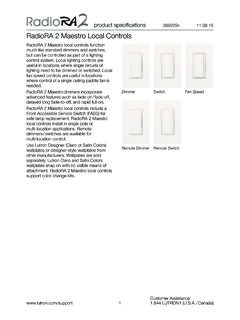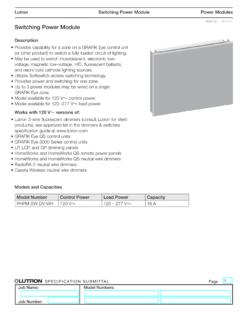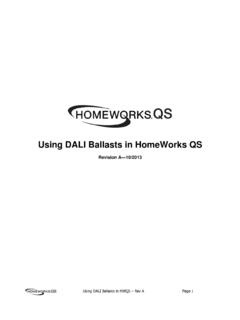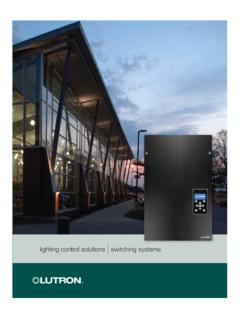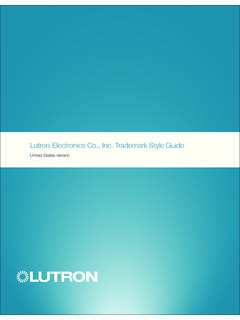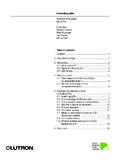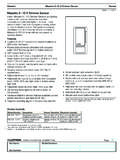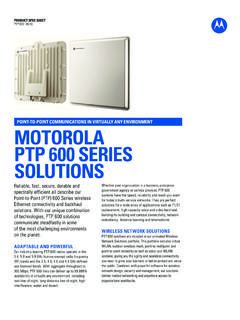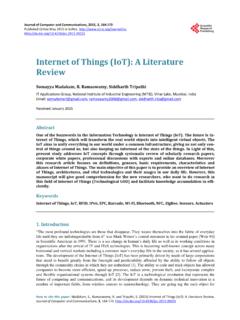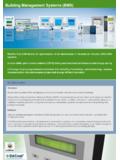Transcription of RTISS Operation - Lutron Electronics
1 RTISSTMO perationBob NewmanConsultantTechnical white paperJune 1999 version 2 Real-Time Illumination Stability System for phase-control dimmers I. IntroductionLutron, the world leader in dimming products for nearly 40years, has faced many technicalchallenges in its , Lutron engineers have addressed the issue ofinternational power quality,specifically power line noise,and its negative effect on quality power can causelights to change rapidly aspower source integrity can manifest itself as anoccasional flash, a strobe effect, or a roller coaster or breathing effect. This paper outlines the basicconcepts of dimming, powerline noise, and successful dimming in the presence ofpoor power quality. It identifiesprobable causes of poor power quality and describes howLutron has integrated a patented design enhancement RTISSTM that filters out linenoise to the dimmer to ensureconsistent, quality dimming Switches vs.
2 DimmersIn applications, a dimmer isused in place of a conventionaltoggle switches provide a loadwith one of only two power levels: On and Off. Voltage condition diagrams for these are shown to the the other hand, dimmerswitches provide a virtually infinite number of power levelsto a load based on the positionof the slider or dimmer controlmechanism. Several load voltage diagrams for differentdimming levels are shown inFigures 2A, 2B, and industry standard dimmersoperate using one of four basicdevices: Triac, SCR, FET, orIGBT. These devices are madeinto either phase-control orreverse-phase-control dimmerswitches. The triac is used inthis discussion for simplicitypurposes; however, the issuesand solutions covered in thispaper affect all of these devices,not just phase-control dimmer controls the power to the loadthrough a solid state switch ortriac. The triac turns on and offat regular intervals based upon the AC power source, for exam-ple, 120 times per second on a60 Hz line and 100 times persecond on a 50 Hz |1 Figure 1A OnFigure 1B OffFigure 2A High IntensityFigure 2B ModerateIntensityFigure 2C Low Intensity Using a slider, rotary knob, orother device, a user sets a lightlevel that tells the dimmer,through a potentiometer ormicrocontroller, to provide aspecific intensity level.
3 Thedimmer translates this level into a triac conduction time is defined asthe time between turn-on and turn-off of the triac. Figure 3 A phase-control dimmer issynchronized to the AC software internal to themicrocontroller synchronizes thedimmer with the AC power timing software measuresthe line frequency and the timeat which the AC line crossesthrough zero. Stable, consistentphase-control dimming requires accurate line frequencyand clean zero 4 The microcontroller uses thezero cross information and thecalculated conduction time tocompute when to activate thetriac. Based on the ACpowerline frequency, the timingcircuit calculates the time thatthe triac remains active. After ithas stayed on for the calculatedtime, the triac automaticallyturns itself off just as the ACcurrent crosses zero. Thissequence provides the exactamount of conduction time;therefore, provides therequested light level.
4 To achieve smooth, flicker-freedimming, the microcontroller stiming circuit needs valid, highlyaccurate, zero cross informa-tion. Corrupt zero crossinformation could impact theturn-on points and conductiontime of the solid-state switchwhich ultimately affects dimmingquality. This information isdependent upon the quality ofthe power line. These two requirements, zerocross information and accurateline frequency, are unique todimming. Other equipment thatuses electricity is not concernedwith these two factors. Acommon misconception is that computer equipment is just as sensitive to power lineanomalies. In fact, becausedimmers do not store energy as power supplies in computersdo, they can be more sensitiveto power line quality |LutronTriac firingpointZero crosslocation0 VoltsThe time betweenthese two pointsis used to calculate the line 3 Triac Conduction TimeFigure 4 Zero Cross andLine Frequency III.
5 ResearchThroughout its research, Lutronhas identified six different types ofpower line anomalies: High-frequency noise Impulse noise Low-frequency non-harmonicsand signaling systems Notches and low-frequency noise RMS (Root Mean Square) voltage changes Variable fundamental frequencyThese specific conditions are theresult of the various building powerdistribution systems that exist. Atypical system is shown in Figure and transformer impedanceas well as disparate loads/systemsfed from a common distributionpanel will affect the severity of the 5 Lutron isolated these conditionsafter reviewing over 150 samplesfrom a multinational installationbase. All samples reviewed were gathered in facilities whereproblems were occurring regularlyand noted by knowledgeable to this point, Lutron equipmentwas well-suited to handle any oneof the six conditions individually.
6 (For example, if the RMS voltagechanged up to 2%/line cycle, the dimmer operated properly.)However, when multiple conditionsoccur simultaneously, poor qualityproblems could result in poordimming |3 UtilitytransformerTr ansformerimpedanceTr ansformerimpedanceDistributionpanelsWire impedanceWireimpedanceWire impedanceHVAC loadsBuildingtransformerselevator loadspumps and fire systemslighting loadstenant connected loadsHVAC loadslighting loadstenant connected loadsLoads andsystemsFigure 5 Building Power Distribution System 4|LutronFigure 6 High Frequency Noise >5kHz Caused by: Variable-speed motordrives, on-line UPS systemsFigure 7 Impulse NoiseCaused by: Switch arcing(loads switching on/off) Figure 8 Low Frequency Non-Harmonics and Signaling SystemsCaused by: Signaling systems,power line carrier communications Figure 9 Notches and LowFrequency Noise 100 - 5kHzCaused by.
7 Elevators and largeindustrial loadsFigure 10 RMS Voltage Changes Caused by: Heavy loads switchingon/off Figure 11 VariableFundamental FrequencyCaused by: Backup generators,relatively small power grids The figures to the leftillustrate the six power lineanomalies. These conditionscan exist individually or in combination. They aredynamic and can disappearand re-appear over time asloads on the power linechange. To properly recreateand analyze the conditions, Lutron developed a method for bringing exactfield conditions into theengineering lab. Lutroninvented a recording method that uses a digital audio method records severalhours of line voltage ontodigital cassette. Using thesecassettes, Lutron engineersare able to recreate exactfield conditions in a lab environment. Lutroncontinues to compile a library of power line conditions fromaround the world, whichprovides authentic testinggrounds for proposedproduct changes.
8 IV. SolutionLutron s original solution for filtering out single instances of power line anomalies was a digitalfilter called a phase locked loop (PLL). Throughconstant monitoring of the zero cross location,the PLL would average any noise presented tothe dimmer. Adjusting the system meantenabling or disabling the PLL or changing howquickly it tracked PLL system worked well when only one power line anomaly existed. If two or moreexisted simultaneously, the PLL becameinadequate. To accommodate instances ofmultiple simultaneous anomalies, Lutrondeveloped its next generation zero cross filter,RTISSTM Real Time Illumination StabilitySystem. The development effort resulted in an analog filter used by the microcontroller stiming filter was designed to eliminate anyfrequency content that has the potential tocorrupt the timing circuit. It provides stable syncpulses for the micro-controller in the presence ofpoor power quality.
9 Figure 12 illustrates how the filter operates. The top waveform shows an unstable, distorted inputvoltage. The bottom waveform shows the resultof the filter circuit what is actually provided tothe microcontroller timing ConclusionIncorporating the zero cross filter intomicrocontroller-based products allows Lutron sproducts to continue to provide superiorperformance. It helps to ensure that Lutron scustomers will not experience inconsistent or unreliable dimming simply because powerconditions at the installation vary or are of poor quality. Continuing its commitment to providingexceptional lighting controls, Lutron isincorporating the recording tools it developedinto the design verification process for all itsproducts. Lutron 's products are tested underworst-case, real-world conditions before theyleave the lab. This process ensures that Lutronproducts not only meet, but exceed customerexpectations now and in the future.
10 Lutron |5 Figure 12 - Input Voltage and FilteredVoltageNote: The RTISS filter circuit is not a powerconditioner to the dimmer. It does not affectthe power profile out to the load, it onlyprovides a clean signal to the timing circuit soaccurate zero cross and frequency informationis available for the triac. Tel: : +1 more information about choosing the best lighting control system for yourstadium or arena project, contact your localLutron representative:World HeadquartersLutron Electronics Co., Inc. 7200 Suter RoadCoopersburg, PA 18036-1299 USAB arcelona +34 93 496 5742 Beijing +86 10 8525 1867 Berlin +49 30 9710 4590 Hong Kong +852 2104 7733 London +44 (0) 207 702 0657 Madrid +34 91 567 8479 Paris +33 1 44 70 71 86 Shanghai +86 21 6288 1473 Tokyo +81 3 5575 2004 Lutron Electronics Co. Inc.
